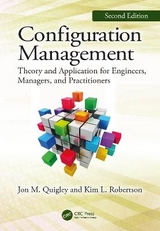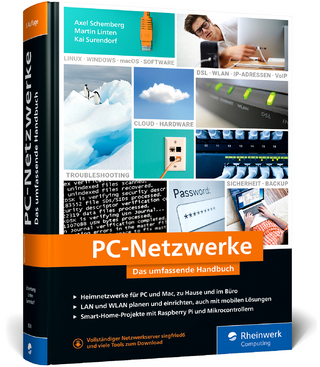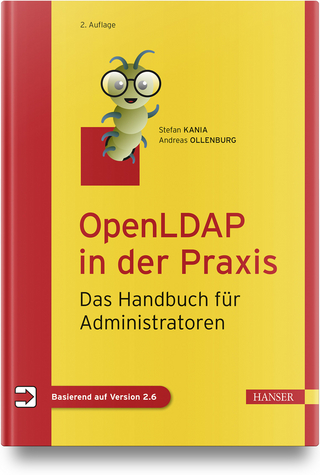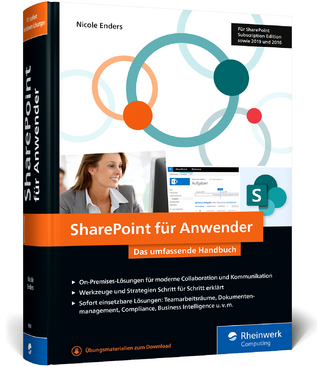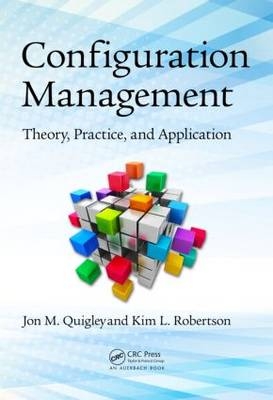
Configuration Management
Apple Academic Press Inc. (Verlag)
978-1-4822-2935-6 (ISBN)
- Titel erscheint in neuer Auflage
- Artikel merken
The book also describes the importance of configuration management to other parts of the organization. It supplies an overview of configuration management and its process elements to provide readers with a contextual understanding of the theory, practice, and application of CM.
Explaining what a configuration item is and what it implies, the book illustrates the interplay of configuration and data management with all enterprise resources during each phase of a product lifecycle. It also demonstrates the interrelationship of CM to functional resources.
Shedding light on current practice, the book describes CM baselines, configuration identification, management baseline changes, and acceptance criteria for end products. It also considers testing, inspection and evaluation, related CM standards, and reference data. Coverage includes the product life cycle, the supporting enterprise infrastructure, functional resources, product management, CM elements, data types, and control requirements.
Providing a systems perspective of the various elements of configuration and data management, the book explains how they relate to the enterprise and details proven risk management solutions for when things go wrong.
Jon Quigley has worked in a variety of capacities within new product development organizations, including embedded product development engineer, product engineer, test engineer, electrical and electronic systems engineering manager, electrical and electronic verification and test manager, and electrical and electronic process manager. Jon is on Western Carolina University’s Master of Project Management Advisory Board and Forsyth Technical Community College’s Advisory Committee for the Project Management Program. Additionally, he has taught project management at technical schools, Seattle City University, and a number of businesses. He is also an expert at IT Metrics and Productivity Institute (www.itmpi.org), where he has webinars on a variety of topics. Kim Robertson started his first company at the age of 18 and has extensive experience in all aspects of business and aerospace, spanning 40 years. He is the author of over 100 discipline-specific training packages, 3 fiction books, and articles for CM Trends and various other trade publications from industrial arts to configuration management and contract management. His interests in education and training development started in his teens. He is a National Defense Industrial Association-certified configuration manager with degrees from Westminster College in mathematics and physical sciences and a master’s degree from the University of Phoenix in organizational management, with a subspecialty of government contracts. His work experience includes wildlife art, photography, electrical circuit design, manufacturing, learning systems design, systems engineering, configuration management, contracts administration, policy and review, intellectual property, corporate audit, corporate finance, supply chain management, marketing, and public speaking. Kim is an associate of Value Transformations LLC.
DEFINE THE BASIS OF TERMS AND THEIR CONTEXT
Overview of the Product Life Cycle
Questions to Ponder
Introduction
Phases
Development
Introduction
Growth
Maturity
Decline
After the Decline
CM and the Dynamics of Change
Survivability Conditions
Evolution of the Horseless Carriage
Product Market Adaptation
Product Performance Adaptation
CM and Market Adaptations
Mass Customization
Performance Adaptations
Case Studies
Case 1—Product Market Adaptation versus Performance Adaptation
Case 2—Share Design Decision
Overview of the Supporting Enterprise Infrastructure
Questions to Ponder
Introduction
Information Technology
A Brief History of Information and Information Security
Stability of Internal Infrastructure
Overhead, General and Administrative, and Other Cost Elements
Intellectual Property
What Is IP?
What Drives IP?
How It Applies to CM
Why Is It Necessary?
IP and Legal Documentation (Incarnations or Permutations of the Design)
International Traffic in Arms Regulations
Counterfeit Products Circa 800
Functional Resources
Questions to Ponder
Introduction
Project Management
Project Integration Management
Scope Management
Time Management
Project Communications Management
Project Cost Management (Earned Value Management)
Project Quality Management
Project Risk Management
Action Item List
Engineering
Design and Requirements
Simulation and Verification
Bills of Materials and Bills of Documentation
Production
Production Setup
Production Test and Verification
Finance
Legal
Contracts Department
Supply Chain Management
Facilities
Property Management
Configuration Management and Product Management
Questions to Ponder
Introduction
Marketing
Product
Price
Promotion
Place
Marketing and Market Research
Customer Interface
Market Segmentation
Increasing the Complexity of the Product
Embedded Software
Embedded Hardware
System Complexity
Distributed Product Development
Outsourced Coordinated Development
A Configuration Item and What It Implies
Questions to Ponder
Introduction
Serialization
Traceability
Higher Level of Management Controls
CM Planning
Configuration Identification
Change Control
Configuration Status Accounting
Configuration Audit
Metrics
Data Definition, Data Types, and Control Requirements
Questions to Ponder
Introduction
Data Definition
Knowledge Workers Spend 30% of Each Day Looking for Data with a 50% Success Rate
Data, If Found, Contains between 10% and 25% Data Inaccuracies
Lack of Data Cross-References and Coordination
Inadequate Data Definition Resulting in the Data Being Misinterpreted
Inadequate Data Safeguards
Multiple Sources of Truth for the Same Data
Too Much Data and Not Enough Intelligence
A Strict Data Diet
3D Printing
Quantum Computing
Database Transfers
Social Media, Real-Time Video/Images, and Text Messaging
CM and Levels of Quality Business Systems Management
Level I, Policy Management
Level II, Plans Management
Level III, Process Management
Level IV, Procedures Management
Level V, Metadata Management
Level VI, Guidelines Management
Level I, II, III, and IV Requirements Management and CM Planning
Configuration Management
Questions to Ponder
Introduction
Overview of CM
History of CM
Das V-Modell
What Does CM Apply To?
CM Process Elements
Requirements and CM
DEFINE THE INTERRELATIONSHIP OF CM TO FUNCTIONAL RESOURCES
Configuration Management Support of Functional Resources
Questions to Ponder
Introduction
CM and Project Management
Acceptance
DD form-250 Use
CM and Project Integration Management
CM and Scope Management
CM and Time Management
CM and Project Communications Management
CM and Project Cost Management (Earned Value Management)
CM and Project Quality Management
CM and Project Risk Management
CM and Action Item Lists
CM and Engineering
CM and Production
CM and Finance
CM and Legal
CM and Contracts Department
CM and Supply Chain Management
CM and Facilities
CM and Property Management
Time-Phased CM Activities
At Award
Critical Noncontract-Related Activities
Hardware Quality Instruction and Software Quality Instruction
The Program Data Repository Basics
The First 90 Days and Beyond
The 90/90 Rule
CM Interfaces
Program Do’s and Don’ts
The Many Faces of CM
The Property Management Interface
DD-1149, Requisition and Invoice/Shipping Document
Shippers and DIL Deliveries
Certificates of Conformance
Summary
DEFINING CURRENT PRACTICE
Configuration Management Baselines
Questions to Ponder
Introduction
There Are Many Baselines
Functional
Allocated
Developmental
Triggers for Moving from One Baseline to the Next
CM Implications of a Product Baseline
Baselines and Configuration Identification
Phase-Based Item Re-Identification
Validation and Verification in Nongovernmental Sales
Product Acceptance
Configuration Control
Questions to Ponder
Management of a Configuration
CM Is a Management Tool
The CM Tower of Babel
Use Drives the CM Planning and Management Systems Design
Six Sigma
Multiple Build End Item and a Product Baseline
One-Off End Items
Management of Change
Engineering Change Request
Engineering Change Orders
Configuration Verification
Functional Aspect
Aids to Functional Aspect Verification
Systems (Product) Verification
Live Fire Exercise
Analysis, Inspection, Test, and Demonstration Master Plan
Requirements and Closure
Configuration Audit
In-Process Audits
Formal Audits
Material Receipt and Inspection
Goods
Production Material
Process Material
Customer-Furnished Material
WHEN THINGS GO WRONG
When Things Go Wrong!
Areas of Configuration Management Risk
Hardware and Software Integration
Commercial Titan—Intelsat 603
Космос-3М—QuickBird 1
Items Delivered of Unknown Configuration
Ineffective ICWGs
Missile-X Interfaces
Mars Climate Orbiter
Milestone Slips because Metrics Were Not Used to Determine
Where a Project Was
Throwing Decisions over the Fence
Company-Level Procedural Approval Holds Up Multiple
Programs
Inordinate Change Processing Duration and Number of Changes
Low Temperature Microgravity Physics Facility
Lack of Change Implementation after Approval
Apollo 13 Oxygen Tanks
Lack of Control of Item Identification
General Motors Corporation Switch Recall
Undocumented Changes or Part Substitution in Final Product
Solar Maximum Mission
1978 BMW 320i w/Four Speed Getrag Gearbox Pilot Shaft Bearing
Drop-In Replacement Sometimes Not So
Lack of Proper Configuration Control Board Stakeholder Review
Harness Support Bracket Redesign w/o Harness Team Input
Small ICBM Internal Shelf Design
Informal Change Management
Open Loop and Stove Pipe Changes
High Rate of Scrap and Repair
Untested Item Substitution
Maintaining Software and Its Associated Design Documentation
Source Code and Compile
Merge Failure
Lack of Baseline Control
Subassembly of Switch
Insufficient Development Baseline Definitions
Lack of a CM-Managed Functional and Allocated Baseline
Design Baseline Updated from Wrong Revision
Inadequate Training of Those Performing CM Functions
What Is the Point of Processing an Engineering Order
Where Is That Written Down?
No Records to Combat Environmental Violation Allegations
Quotations
TIEMPO, RELATED CM STANDARDS, AND REFERENCE DATA
Test, Inspection, and Evaluation Master Plan Organized
Philosophy of the Master Plan
Benefits of the Master Plan
An Overview of One Approach
System Definition
Test (Verification)
Reliability Testing
So, When Do We Start Testing?
Types of Tests during Development
Inspections
Evaluation (Validation)
Inspection Caveats
Product Development Phases
Conclusion
Appendix: Related Configuration Management Standards
Acronyms
Bibliography
Index
| Zusatzinfo | 145 Illustrations, black and white |
|---|---|
| Verlagsort | Oakville |
| Sprache | englisch |
| Maße | 178 x 254 mm |
| Gewicht | 998 g |
| Themenwelt | Mathematik / Informatik ► Informatik ► Netzwerke |
| Mathematik / Informatik ► Informatik ► Software Entwicklung | |
| Technik ► Elektrotechnik / Energietechnik | |
| ISBN-10 | 1-4822-2935-8 / 1482229358 |
| ISBN-13 | 978-1-4822-2935-6 / 9781482229356 |
| Zustand | Neuware |
| Informationen gemäß Produktsicherheitsverordnung (GPSR) | |
| Haben Sie eine Frage zum Produkt? |
aus dem Bereich
